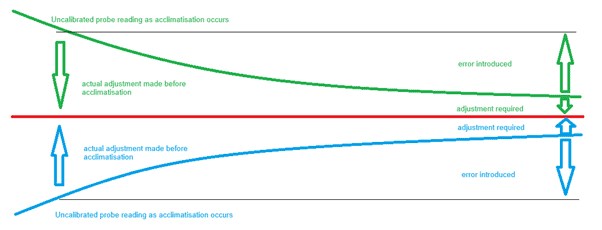acclimatize
/əˈklʌɪmətʌɪz/
verb
become accustomed to a new climate or new conditions; adjust.
TECHNICAL
respond physiologically or behaviourally to a change in conditions in the natural environment.
Applies to all dataloggers, but shows up in different ways depending on the layout of the input card – they all have a sensor somewhere in the card that measures the temperature there, and one in the middle of the logger – it then creates an adjustment based on the temperatures at both points, so it’s really important that the logger is turned on & left to get to operating temperature (NOT left in the room powered off & left overnight to get to room temperature as it’s going to be cooled than ‘operating temperature’)
As the temperature inside the logger rises, the reading of the sensor (thermocouples or otherwise) will gradually shift, until the temperature reaches equilibrium. This can be observed if you start logging immediately on turning the datalogger on with the thermocouples at a set temperature in the heat bath – the trace will very gradually shift in temperature as the logger reaches its internal operating temperature while the temperature of the probes in the bath remains the same. Loggers with the sensor connections in a long line will see a gradual shift across the range from one end to the other, but on the Fluke Netdaq (with 1-10 and 11-20 in parallel) this is easier to spot, as the two groups shift in tandem in opposite directions – examples below are therefore from the Netdaq purely because it is easier to observe the difference between the two sets of probes, but this effect occurs with all types of datalogger
This can be seen quite easily if you start logging in TQSoft immediately after turning the datalogger on with the thermocouples in a thermal bath at a set temperature(an especially if it is cold outside and the datalogger has been sat in the van overnight!). As the logger warms up, the measured temperature will gradually change despite the temperature of the bath remaining the same – this becomes more noticeable at higher temperatures.
Where this gradual temperature shift becomes particularly important is during an initial calibration. If a calibration adjustment is performed before this equilibrium is reached, the adjustment will not be correct, as it doesn’t take into account any further shift in temperature after the point of adjustment.

Because the probes have been adjusted by more than required, one block of probes will read higher than they should, and the other lower, which can lead to a noticeable gap in the measurement of the two groups – the actual reading should be in the middle – generally the higher the measured temperature the more noticeable the difference. While this may not be noticeable during testing, as there is usually an allowed band of 3 degrees or more, the calibration check has an allowed deviation of only half a degree, which may be exceeded if the initial calibration has been performed from cold.

Unfortunately, this is only usually noticed after testing when the calibration check fails. Again with reference to the Fluke Netdaq, if you look at the measured readings at the set point, you will see that probes 1-10 are grouped together but deviate from the reference in one direction, while probes 11-20 are are grouped together but deviate from the reference in the other. By this point, however, it is too late, as the error was actually in the initial calibration, and there is nothing that can be done to rectify it as the tested cycles are all affected.
Isopharm would generally recommend that any datalogger is powered on for at least 30 minutes before a calibration is performed, and longer than this if the logger is particularly cold when powered up – 45 minutes to an hour if possible.
